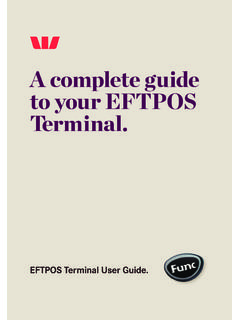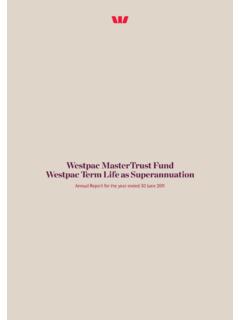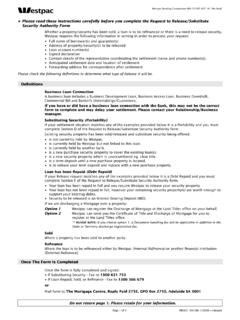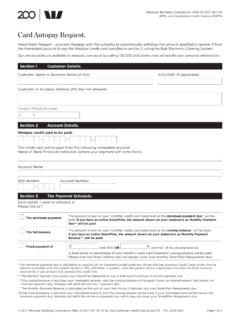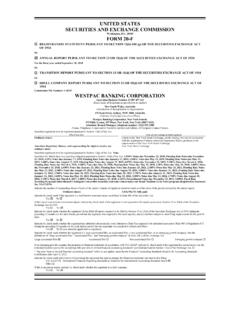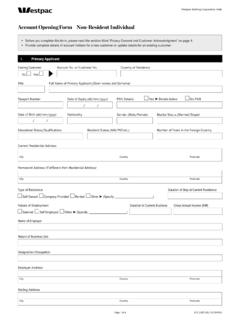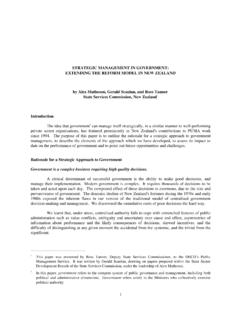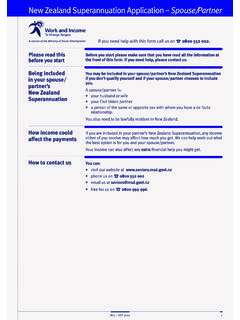Transcription of Australia New Zealand weekly. - Westpac
1 Australia & New Zealand Institutional BankWeek beginning 11 June 2018 Public demand and exports lift Australian growth above trend, but consumer still patchy. RBA: Governor Lowe and Assistant Governor Economic Ellis speak. Australia : Westpac -MI Consumer Sentiment, employment, housing finance, Westpac -AusChamber Manufacturing Survey. NZ: retail card spending, house sales & prices. China: new loans, retail sales, industrial production, fixed asset investment. US: FOMC policy decision & press conference, CPI, retail sales. Central banks: ECB and BOJ policy decisions. Key economic & financial contained in this report current as at 8 June performance is not a reliable indicator of future performance.
2 The forecasts given above are predictive in character. Whilst every effort has been taken to ensure that the assumptions on which the forecasts are based are reasonable, the forecasts may be affected by incorrect assumptions or by known or unknown risks and uncertainties. The results ultimately achieved may differ substantially from these weeklyPublic demand and exports lift Australian growth above trend, but consumer still patchy The Australian economy performed solidly over the past year as evident from labour market trends and as confirmed in the March quarter National Accounts. However, areas of weakness persist and are likely to weigh on the increased by in the March quarter, lifting annual growth to This is an above trend outcome, with trend judged to currently be around Non-farm GDP grew by over the year, the strongest annual outcome since 2012.
3 Domestic demand is expanding by a little in excess of 3%, + over the past year, well up from the sluggish outcomes of around 1% prevailing over 2013, 2014 and increasing by over the year, and by for the non-farm economy, brings output growth more in to line with job creation, with employment growth a brisk over the conditions have been supported by a combination of powerful global and domestic forces, namely:(1) The global backdrop is more favourable. World growth accelerated in 2017 to , up from , the strongest pace since 2011. We expect world growth to hold around this pace in 2018, supported by a strengthening of conditions in the US. However, conditions in our number one trading partner, China, are likely to moderate somewhat this year.
4 (2) Commodity prices are up off the lows of late 2015 and early 2016, improving cash flows for miners and triggering a shift away from the earlier cost cutting mindset. Higher commodity prices have also supported government tax revenue collections. (3) The mining investment drag is greatly diminished, albeit not quite complete, with the remaining gas projects under construction to be completed over the coming year.(4) Non-mining investment is trending higher, led by construction activity, as the capital stock expands to meet the needs of a fast growing upshot is that business investment turned the corner in 2017, up 6%, following four years of decline, averaging per year.
5 In Q1, business investment consolidated, + , constrained by a dip in non-residential building work, which will be quickly reversed given the strength of approvals.(5) Public demand, a quarter of the economy, is expanding at a well above trend pace. Investment is in an upswing, up from the lows of 2015, and additional resources are being directed to health. In Q1, public demand grew by , , directly adding to activity over the year, with additional positive spill-over effects.(6) Exports are a growth driver, directly adding to activity over the past year. LNG exports are expanding strongly as new capacity comes on stream and service exports have been growing solidly, although current estimates suggest a recent consolidation (one that may well be revised up as additional information becomes available).
6 Supply disruptions have contributed to a choppy export profile, with flow-on effects to activity. Net exports swung from a subtraction in Q4 to a positive contribution of in Q1. These global and domestic developments have led to conditions becoming more synchronised across the state economies, contributing to a stronger national result. This is particularly evident in job trends, with employment trending higher across each of the major states during have recognised the significance of these key themes, which were broadly confirmed in the March quarter National , there are some prevailing weaknesses, particularly around the consumer and housing. The consumer remains vulnerable at a time of weak wages growth, high debt levels and slipping house prices.
7 The housing sector is cooling as lending conditions tighten, with prices easing back from recent highs. Consumer spending has been mixed in early 2018, expanding just in the March quarter, keeping annual growth at Household demand is tracking slightly below trend and remains choppy. The absence of above trend consumer spending remains a striking feature of the post GFC period, contributing to the absence of material inflation assess that the current pace of consumer spending is likely unsustainable and anticipate a moderation in spending growth to around for the 2018 year as a whole and to remain at this rate for 2019. Notably, consumer spending has also been supported by a moderation in the savings rate, declining from a year ago to a relatively low currently.
8 The scope for a further run-down of the savings rate is now diminished. On incomes, total labour income posted a solid rise in the March quarter. This, along with upward revisions, lifted the trajectory for annual growth. At it is now running at the fastest pace since June 2012, although it is still half a per cent below the average over the last fifteen years. Labour income is showing a particularly sharp turnaround in the mining states, annual growth now tracking at just over 5% in both Qld and , the key point is that strength in labour incomes is largely centred on the recent hiring burst, which has subsequently faded. Wages, as measured by average compensation of employees (non-farm) grew by only over the year to be flat in real terms.
9 Weakness in wages growth reflects, among other things, ongoing labour market shifts in jobs growth have been quite marked. An undershoot in 2016, associated with uncertainty around the Federal election, was followed by a hiring burst, in part a catch-up. Jobs growth of in the year to the March quarter 2018, which is twice population growth, is unsustainable. Indeed, employment growth has subsequently slowed, to annualised for the initial four months of 2018 - for the full year we expect jobs growth of around to home building activity, this contracted by in 2017, consistent with the decline in dwelling approvals from the historic highs of 2016, largely centred on high rise projects.
10 This downturn has further to run with the contraction accelerating into 2019 after a near-term consolidation over the first half of 2018 (home building actually made a small positive contribution to growth early in 2018). Large increases in new supply and a marked slowdown in sales to foreigners are weighing on the outlook for residential consideration is the potential for heightened political uncertainty ahead of the next Federal election, due by mid-2019, which could see businesses delay spending and summary, key positives around pubic demand, business construction investment and exports will provide a solid base for overall economic activity during 2018. However, with weaknesses in consumer spending and housing we expect GDP growth to moderate to in the year to December 2018 and then slip to a below trend for December Hanlan, Senior Economist3 The week that wasPast performance is not a reliable indicator of future performance.
